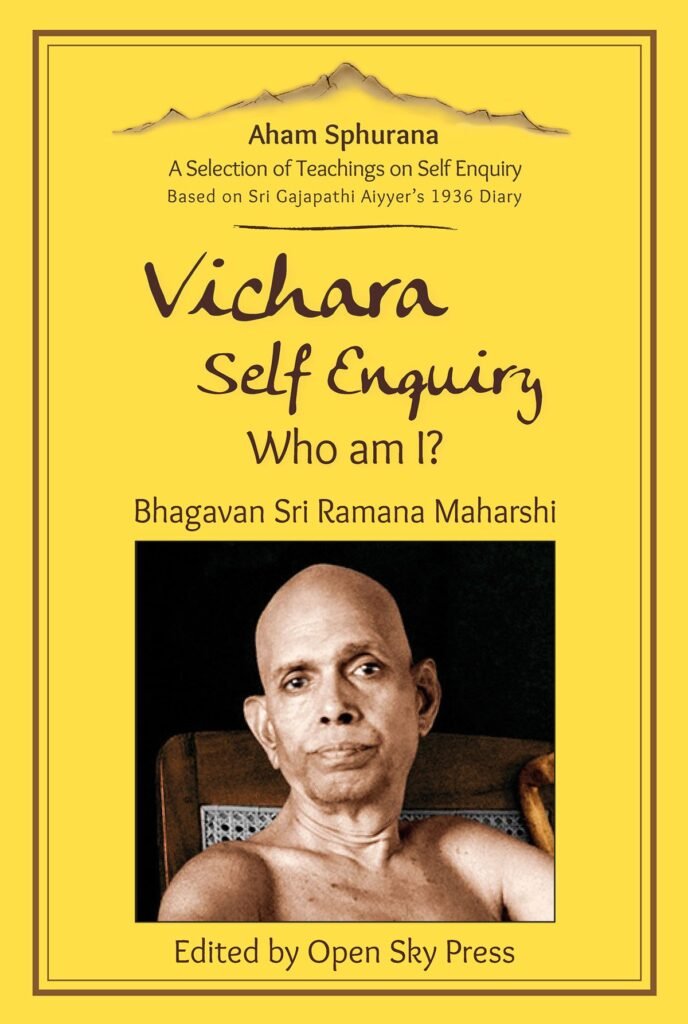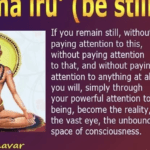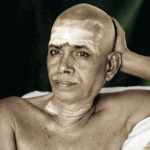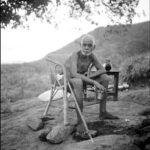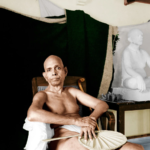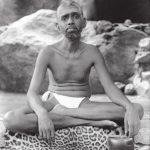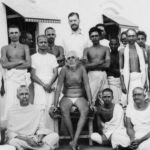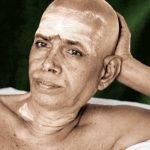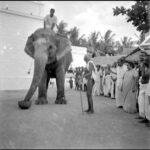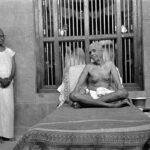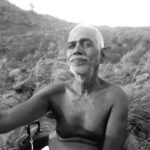Blog
Spiritual Teachings
from the Heart of Satsang
Browse by Topic through the Archive
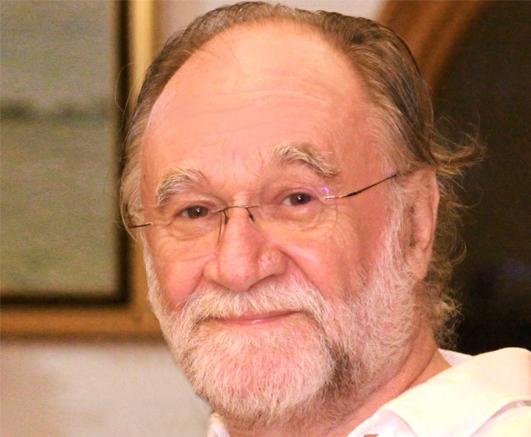
Or use the Search Function
Latest Blog
Rooting Out the Ego and Persevering on the Path
Sri Ramana Maharshi
on Rooting Out the Ego and Persevering on the Path
Edited by John David Oct 2021
INTRODUCTION
In this blog “Ramana Maharshi on Rooting Out the Ego and Persevering on the Path,” we explore the transformative practice of self-enquiry as taught by Sri Ramana Maharshi. Central to his teachings is the idea of eradicating the ego at its root, a crucial step for anyone committed to true spiritual progress. We delve into how perseverance on the spiritual path, as emphasized by Ramana Maharshi, is essential for overcoming the obstacles of the mind and ego, which continuously try to pull us away from our natural state of pure awareness. By embracing self-enquiry with determination, we uncover the deeper truths of our existence and move closer to lasting inner peace.
Available Worldwide
on www.openskypress.com and Amazon:
Amazon DE
Widely appreciated
“In my opinion, Aham Sphurana, a Glimpse of Self Realisation, will become a Treasure Trove of Wisdom to the Seekers of Truth in general, and particularly to the devotees of Bhagavan.”
Swami Hamsananda – Athithi Ashram, Tiruvannamalai
“This collection is a profound offering for those who are inspired to deeper inquiry. I have read both volumes for myself and others. Many passages reveal freshly and intimately the gift that is Ramana Maharshi. This is a book to cherish.”
Gangaji
“Thanks for presenting the book. I went through the book and it is indeed a good read. As you have mentioned, certain portions are controversial. However, many portions on Self-enquiry (genuinely in Bhagavan’s words) are profound and helpful to the seekers. Pranams”
Sri Ramanacharana Tirtha Swami
(formerly Sri Nochur Venkataraman),
“An excellent book suitable for anyone serious about the spiritual life and committed to knowing profound and liberating realisations. The beauty of Ramana’s teachings shows in the unwavering directness with a remarkable clarity and simplicity. Meditate on the questions and responses. Listen inwardly beneath the mind’s activity.”
Christopher Titmuss
“Aham Sphurana is the most profound, subtle and practical version of Ramana Maharshi. When you read this book you realise just how diluted, vague and lacking are most of the books published in the name of this great sage of Arunachala.
It is not an easy new age read, it is the real deal with all its subtleties and intricacies. Our role is to develop a profound, sensitive and subtle mind and heart to understand and absorb these teachings.
The persons who wrote and published this book faced fierce objection from many people and are no less than warriors of spiritual truth.
Their devotion and respect to Ramana Maharshi made them fight this war and they deserve our appreciation and respect for making these rare teachings available to us.”
Noah
2nd Volume
now available
on www.openskypress.com and Amazon:
The pristine, pure mind of the Master that speaks through this profound volume is bound to bring us to an awakening into the most obvious yet hidden truth of our own existence.
Pravrajika Divyanandaprana
Rooting Out the Ego and Persevering on the Path
Q: Which is genuine Vichara – asking myself Who am I? every time a thought arises or keenly investigating the problem of who I am?
B: The latter. If you want to get rid of a poisonous tree, do you lop off its leaves one by one? What is the use of such an approach? In the time it takes for you to cut down one leaf, leaves multitudinous in number and multifarious in variety would have sprouted forth from the vicious tree. Instead, attack the poisonous root of illusion, namely the ahamvritti, straightaway!
Q: But I have heard it spoken of amongst Bhagavan’s devotees that Vichara, according to Bhagavan, can be compared to an aged mongoose waiting for a snake to come out of a discarded anthill that the latter happens to be using as its place of residence.
B: Yes. The sword can be used for slicing as well as for stabbing. In the preliminary phase of sadhana, when thoughts rush out furiously one after the other, Vichara is used as a tool to go on returning the mind to its native state of thought-free pure Subjective Consciousness. It is always to be practised as and when it is discovered that the mind has strayed away from this natural state. However, there is also the subsequent stage, where thoughts have largely subsided. Now, the investigation Who am I? is used to seek the mind with mind. Use the mind to scrutinise closely what ‘I’ is. Rather than creating something called ‘I’ and then looking at it so as for fulfilling the instruction to closely scrutinise ‘I’, seek ‘I’, whatever it might be and whether it might exist or not, without harbouring notions as to its existence or non-existence.
Q: I am trying to follow Bhagavan’s instructions. But my vasanas prove to be an obstacle. What can I do?
B: Never mind obstacles. Keep on going. Do not sit down or pause to moan or complain, but keep on going. The only important thing is to keep on going. If you try to take stock of progress yet to be made, you will feel alarmed and then further progress would have become impossible. So, never stop, but go on escalating. One day you will reach the summit, or rather, realise that you never left it. Until then, climb relentlessly and incessantly. Do not bother about obstacles, progress, and the like. Simply and only, go on scaling.
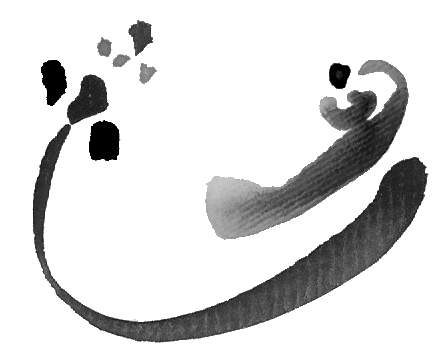
More from Ramana Maharshi
Summa Iru
Summa Iru means resting quietly, free from thought and activity, allowing the mind to dissolve and reveal natural peace.
Mr. Evans-Wentz’s Visit
A visitor finds peace and wisdom with Ramana Maharshi, experiences deep spiritual moments, and departs with profound gratitude and joy.
Complete Cessation of Mental Activity
Only the complete, motiveless cessation of mental activity reveals the Self, showing the personal ‘I’ never truly existed.
Vishwanatha Aiyyer and the Monkey
Bhagavan recounts how the monkey Shabarigirisan miraculously inspired a boy to return home, illustrating the mysterious grace of Arunachala.
Consciousness
The “I”-sense is not even remotely connected to anything physical. Being of the nature of consciousness, it emanates from the Self only.
Ripe Souls Attain Jnana
The Jnani’s silent presence works like a magnetic force, effortlessly turning ripe minds inward, leading to natural, thought-free peace.
Sri Gajapathi Healed and Attacked
Through Grace, Love, and remembrance, illness was healed, fear dissolved, and an enduring devotion to Bhagavan and Hanuman remained.
How we Sabotage Vichara
Sabotage ends when we discard the ‘I’ that strives for Realisation, resting in pure Subjective Consciousness, free from identification.
A Small Wise Boy
Through a boy’s spinning top, Bhagavan reveals that prarabdha spins itself out naturally, beyond the Jnani’s identification.
A Dog and A Monkey
Through Grace and surrender, one is lifted beyond samsara, like the monkey safe from the barking dog, untouched.
Get Your Copy of the Book
Aham Sphurana
A Glimpse of Self Realisation
New Book about Sri Ramana Maharshi

Available Worldwide
On www.openskypress.com and Amazon:

“In my opinion, Aham Sphurana, a Glimpse of Self Realisation, will become a Treasure Trove of Wisdom to the Seekers of Truth in general, and particularly to the devotees of Bhagavan.”
Swami Hamsananda – Athithi Ashram, Tiruvannamalai

Danger of Emptiness [shunyastithi]
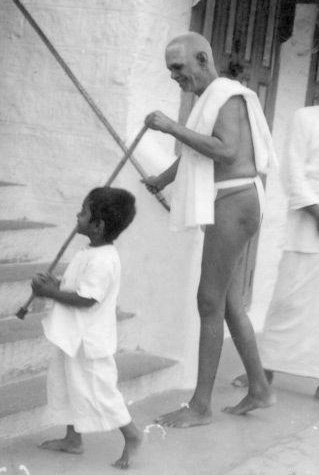
Aham Sphurana
A Glimpse of Self Realisation
New Book about Sri Ramana Maharshi

Available Worldwide
On www.openskypress.com and Amazon:

“In my opinion, Aham Sphurana, a Glimpse of Self Realisation, will become a Treasure Trove of Wisdom to the Seekers of Truth in general, and particularly to the devotees of Bhagavan.”
Swami Hamsananda – Athithi Ashram, Tiruvannamalai
Danger of Emptiness [shunyastithi]
Bhagavan: ( )…Otherwise, the aspirant will in all likelihood unknowingly mistake the shunyastithi [state of emptiness] to be Jnana and rest in it, eventually becoming hopelessly lost.
It is an unfortunate fact that many teachers of meditation tutor shunyastithi and purposely delude their pupils into believing that it is Jnana.
Shunyastithi [state of emptiness] is a deadly spiritual poison.
It drives one away from the Heart, thereafter the lost ground has to be recovered all the way by means of doubling-back if Jnana is to be reached. That is why meditation is not encouraged here, but only Vichara.
Edited by John David Nov 2024

Sri Ramana Maharshi
on The Danger of Emptiness
Edited by John David Oct 2021
INTRODUCTION
In this blog, “Ramana Maharshi on the Danger of Emptiness,” Bhagavan warns against mistaking the state of emptiness, or shunyastithi, for true self-realization (Jnana). He explains that many meditation teachers mislead their students into believing that shunyastithi is the ultimate spiritual state, which can lead to confusion and spiritual stagnation. Bhagavan describes this state as a dangerous spiritual poison that distances the seeker from the Heart. True self-realization is reached through Vichara (self-inquiry) and by deeply embracing Ramana Maharshi’s teachings, not through meditation that encourages an experience of nothingness. Bhagavan emphasizes the importance of turning inward to discover the true Self, rather than being distracted by false spiritual experiences that lead away from liberation.
Available Worldwide
on www.openskypress.com and Amazon:
Amazon DE
Widely appreciated
“In my opinion, Aham Sphurana, a Glimpse of Self Realisation, will become a Treasure Trove of Wisdom to the Seekers of Truth in general, and particularly to the devotees of Bhagavan.”
Swami Hamsananda – Athithi Ashram, Tiruvannamalai
“This collection is a profound offering for those who are inspired to deeper inquiry. I have read both volumes for myself and others. Many passages reveal freshly and intimately the gift that is Ramana Maharshi. This is a book to cherish.”
Gangaji
“Thanks for presenting the book. I went through the book and it is indeed a good read. As you have mentioned, certain portions are controversial. However, many portions on Self-enquiry (genuinely in Bhagavan’s words) are profound and helpful to the seekers. Pranams”
Sri Ramanacharana Tirtha Swami
(formerly Sri Nochur Venkataraman),
“An excellent book suitable for anyone serious about the spiritual life and committed to knowing profound and liberating realisations. The beauty of Ramana’s teachings shows in the unwavering directness with a remarkable clarity and simplicity. Meditate on the questions and responses. Listen inwardly beneath the mind’s activity.”
Christopher Titmuss
“Aham Sphurana is the most profound, subtle and practical version of Ramana Maharshi. When you read this book you realise just how diluted, vague and lacking are most of the books published in the name of this great sage of Arunachala.
It is not an easy new age read, it is the real deal with all its subtleties and intricacies. Our role is to develop a profound, sensitive and subtle mind and heart to understand and absorb these teachings.
The persons who wrote and published this book faced fierce objection from many people and are no less than warriors of spiritual truth.
Their devotion and respect to Ramana Maharshi made them fight this war and they deserve our appreciation and respect for making these rare teachings available to us.”
Noah
2nd Volume
now available
on www.openskypress.com and Amazon:
The pristine, pure mind of the Master that speaks through this profound volume is bound to bring us to an awakening into the most obvious yet hidden truth of our own existence.
Pravrajika Divyanandaprana
Samadhi
Bhagavan called Chadwick to his side and said something to him. Chadwick exited the Hall and presently returned with a notebook, Chadwick reads out as follows notes he had made from an early conversation with Bhagavan:
I asked my Master if He would mind giving me a detailed explanation concerning the term Samadhi, and its various kinds. The Lord Ramana graciously assented and sweetly spoke the following words:-
The meaning of the word Samadhi is generally given as Union with Reality, but it is not so. Samadhi means the State of non-differentiation from Reality or THAT – WHICH – IS. The following are its kinds:
1. Savikalpa Samadhi
[thoughts still exist but they do not affect] – mind is forced by effort of will to hold on to pure BEING – without such deliberate attentiveness or volition, the mind starts straying into world of sense-objects or realm of thoughts again – vrittis or concepts remain in latent-form or seed-form – if concentration is sufficiently advanced one progresses from here to Aham Sphurana. This is generally not characterised by loss of body-consciousness – ‘I’-‘I’ pulsation is distinctly felt – bliss experienced – continuous inherence in Aham Sphurana leads to Sahaja [spontaneous enlightenment] Samadhi thus bypassing requirement for Kevala Nirvikalpa Samadhi.
2. Kevala Nirvikalpa Samadhi
– mind temporarily merged in Parabrahman – like bucket dropped into a well, but rope attached using which to haul it up again – rope represents vasanas or vrittis or samskaras [mental imprints] – concepts or vrittis are merely in suspension; they merely temporarily disappear only to reappear after the trance comes to an end – nor was possibility of ‘I’-‘I’ pulsation or any other sensation to be known during the duration of the trance – for that duration of time there is no one whom it can occur to – when the word ‘time’ is used, it refers to the experience (not actual experience, for that is only Being, but apparent impression formed by an extroverted mind) of the onlooker, of time passing.
People immersed in Kevala Samadhi are not conscious of passage of time because for that duration, as marked only by the observer, he is dead as an individual and alive only as Reality – no mind during kevala trance – thus, not possible to cognise anything known as ‘time’ – complete absence of body-consciousness – even involuntary bodily functions cease – body becomes cadaver – no way to tell apart from actual cadaver – occupant body may be abandoned for good due to the intensity of the bliss experienced – if so, taking up of new body, gross/subtle, inevitable, because vrittis remain in seed-form. The difference between yoganidra [yogic sleep] and Kevala Samadhi
– yoganidra brought about based on Patanjali’s teachings or rajayoga [royal path] method misapplied – deadliest of all stumbles on spiritual path – must be very careful to avoid – simply a long spell of sleep-like condition.
Story of man doing what he thought was tapas [austerities], on banks of river Ganges – asks disciple to fetch water from river to drink and goes into trance – wakes up 1000 years later – no river to be found – landscape has changed completely and finds his body immersed in a swamp – first thought that occurs to him after waking from trance – I want water to drink – therefore 1000 years totally wasted.
Yogi thinks experience of pleasure or bliss by him means Salvation – nothing could be more absurd – many doing vichara think they have found Reality and fall into this trap – very difficult to leave – more addictive than cocaine, morphine, etc. – how to find out if one is confronted with this danger – just after a heavy meal where favourite dishes have been served, one is relaxing – there is a pleasant lull in the mind – no thoughts – just pleasure which stands on the threshold of drowsiness – this is precisely similar to condition of yoganidra, only intensity of the pleasure is heightened manifold – mind not thinking, not sleeping, not dreaming, not cut-off to sensory-perceptions totally, but yet NOT Self-aware – just a blank mind.
Many poor souls when asked to remain without thinking go to this state because this is the only thought-free state they know. They think this is the goal of Self-enquiry – think this is liberation – but this is a dead end – worst thing that could happen to a sadhaka – once mind gets used to this sort of poisonous pleasure, would find coming out less and less desirable and therefore progressively less and less possible – no rescue possible after the initial stage – tamasic [darkness] nature grows on increasing – Eternal Damnation.
To avoid, mind must focus not on pleasure, or happiness, or joy but on ensuring absence of distractions to BE-ing – after certain critical limit of tamas [dark, inertia] reached and exceeded, rajas [passion] and sattva [clear, light] reduced to negligible quantities – thus taking on body to alter the balance between the gunas [attributes] so that Realisation can be reached by making sattva only predominant guna, no longer possible because not adequate sattva and rajas left to work with to form body gross or subtle – no help possible.
Tamas grows and grows – body becomes a vegetable and then rots away – mind’s tamas is on the decline – unless Ishwara [the supreme Being] himself takes pity and adds rajas to favourably balance the mix, thus putting the poor soul in some primitive body, so that he can go on from there, increasing sattva, no deliverance possible – great danger in rajayoga [royal path] and kundalini [divine energy] yoga method.
That is why Bhagavan does not encourage – danger exists even for vichara practitioners who want pleasure or bliss more than freedom from bondage – whilst living on the Hill Bhagavan encountered one such yogi Adhityanath – body falling into pieces on account of neglect – everyone thought he was in Samadhi, revered him.
Bhagavan could see the truth – he had lost himself in a yogic trance [yoganiththirai] – Bhagavan tried to help him once – man angrily pushed Bhagavan away, had become addicted to the pleasure, would never give it up – Bhagavan left him to his fate and came away because nothing could be done.
That is why it is important that AWARENESS OF BEING be sustained throughout the sadhana – the moment Self-awareness started to fluctuate or lull tried to take control, one had to stubbornly pull mind back into realm of Being – pleasure or bliss not the goal – only one true goal – destroy possibility of manifestation – consciousness free from upadhis has got to be sustained throughout sadhana for it to succeed – birth man’s greatest disease – common man thinks birth = commencement-of-Existence – nothing could be further from the truth – birth = assumption-of-limitations – this had to be understood at intellectual level before any meaningful sadhana could begin.
3. Sahaja Nirvikalpa Samadhi
[the mind is dead, resolved into the Self] – no description in words could do justice. No concepts, no sensations, no experience, no bliss, no cosmos, no person, no God, no nothing. HE IS THAT in which manifestation and its absence are contained and that by virtue of which presence or absence of manifestation is able to be perceived – experience of the Self by the mind is blissful – Self itself neither bliss nor agony – it is as it is – words trupthi [satiatedness] or shanti more meaningfully describe Self than ananda [bliss], though descriptions cannot afford a glimpse into that state – state known as Sahajastiti, not newly created – even now it is there and you are THAT.
But mind veils it – search for mind – mind never existed, but it is to be practically discovered not to exist so as for Realisation to occur – discoverer himself does not remain to say I have made discovery – only Self remains – end of all effort – ONLY means of freedom from rebirth lies in this state.
Additional Notes: Kevala Samadhi state, though not as bad as nidra [sleep] state, not in fact desirable – does not happen to all aspirants – it is a waste of time that could otherwise be used to destroy vasanas that prevent one from reaching the final goal – goal not to attain Self – what nonsense, who can attain Self – besides the Self what could exist – are there two Selves – goal to destroy illusory not-Self so that Self alone remains.
Kevala Samadhi generally achieved by faithful followers of Patanjali or ashtanga [the eight limbs of yoga] yoga school – again some danger – aspirant would think final goal has been reached once mind has known Brahman once – sheer absurdity – temptation to go into Kevala Samadhi instead of rooting out vasanas intensely because of the terrific bliss felt – thus final goal delayed – right Master has to arrive to convince him this is not final state – problem is, would call himself a brahmajnani [person with knowledge of the Self], think himself to be a knower of Brahman, allow his ego to decline, would not listen to right advice – insensitive behaviour may come on – thus this state best avoided – family-members may be alarmed, may cremate body, no telling when body-consciousness might return – vicharamarga [path of Self-enquiry] by-passes this stage.
Aham Sphurana already described serves as substitute – Kevala Samadhi in fact a by-lane, not to be aspired for – those who want Bliss of Brahman without losing personality or individuality, Kevala Samadhi last threshold for them – jnanamarga does not embrace desire for bliss – vicharamarga aspirant must not aspire at all – remaining naturally without desire is the hallmark of ideal jnanamarga aspirant – even desire for Enlightenment is a serious hindrance – just like you forego other desires, forego desire for trance or bliss or Enlightenment also, by asking, to whom same has occurred.
REMAIN AS YOU ARE – free from thoughts, ideas, desires and all other sorts of vrittis – remaining in natural state alone true freedom, because this state cannot complain about embodiment or bondage – why sahaja Samadhi [the natural state of being] explained only as negation – it is that which is beyond the ultimate – here no one besides the Self exists to experience the bliss of the Self, and the Self is not capable of experiencing anything, not even Itself – no question of perceiving anything – nothing apart from Him for Him to percieve – that is why called Advaita and not ekatva [unity] – no question of jivatman ever reaching Parabrahman – if He be pleased with aspirant’s sincerity, He himself reaches out and destroys him – this action naturally happens – no faculty of volition present in Parabrahman to decide, let us give this jivatman liberation or destroy him.
If jivatman approaches close enough, automatically sucked in and annihilated – but for this jivatman has to approach very very close – Master gives example of asteroids passing close to the sun in orbit – the energy with (or velocity at or whatever it is) which the body is going around the sun and its distance from the sun would usually suffice to ensure that it was not pulled in by the massive gravity of the sun; progressive reduction in either of these two factors would make it more and more likely that the body might crash into the sun – likewise, according to Bhagavan ‘I’-thought and its objectifying tendency were two factors that prevented ego from merging into Self – crush one of them totally, and that was enough – Guru’s Grace like friction-action of debris that gradually reduces the speed of the body and gradually alters the course of its orbit so that it will eventually surely gravitate toward Sun – devotional path snapped ego’s brain, the objectifying tendency – investigation path snapped ego’s heart.
The ‘I’-thought – these two are aspects of same ego – killing one would kill the other and kill the ego – some aspirants ask I am ready for liberation why am I yet to be liberated – it shows they are not ready at all – the truly ready aspirant has no sankalpa [will] or volition left to make any such communication, for the extent of his Self-surrender is total – what is surrender – to surrender is to cease to have any cares, leaving it to the Lord to do as he likes with you.
The truly surrendered one asks nothing because he feels no need, no desire – he does not even want non-Existence of misery, much less aspire for release from samsara – jnani is always in Samadhi whether body moves about or is stationary or is dead – jnani cannot see his body – there is only one thing that He can do and know and that is to BE the Self – people say so-and-so is a jnani – from the jnani’s own point of view this has no meaning – nothing in him to manufacture the assertion I am a jnani – there is simply no one there localised in terms of that body – the wise sadhaka does not decide to quit the household – nor does he decide to move into the jungle – he silently surrenders his faculty of volition to the Higher Power and is meekly led by it wherever it takes him, jungle or household, heaven or hell – since he has already freed himself from the body-am-I idea, he would not think, ‘I am being taken somewhere.’
Unselfish Love for God is called bhakti – unselfish love is not for the sake of acquisition of material possessions, nor for attainment of heavenly realms, nor for attainment of Salvation, nor for breaking free from the wheel of births-and-deaths, nor for fulfilment of altruistic or philanthropic motives concerning upliftment of Humanity – unselfish love is not even accompanied by the hope or expectation of being loved in return; it has nothing to ask – unselfish love simply knows to love, that is all – the earnest bhakta is not affected by the presence or absence of all or any of the worlds – his own apparent Existence is an inexplicable embarrassment for him, for to him everything is the Lord’s.
His will becomes entirely non-existent, the Lord’s will taking its place – that is the love Job in the Bible had for God, that the gopis [female devotees] had for Krishna [supreme God, eighth avatar of Vishnu], that Karna had for Duryodhana, love that knows to love only – if you are able to cultivate this kind of mad, all-consuming Love for God, the resultant intoxication will ensure that worries about employment, means-of-livelihood, et cetera, are kept well away from your mind – the truly surrendered one has no hopes or expectations as to what he wants the future to be; whatever happens, he accepts the same as the will of his Lord; indeed, he sees only the Lord Himself in all the objects and events that he experiences in the jagrat and swapna states – you can never make him experience pain, because the moment his body feels distress, he tells himself, ‘It pleases the Lord to cause one of his possessions to undergo such-and-such sensations; who are we to question His will and why would we need to bother ourselves with the propriety of His decisions? It is for us to meekly submit to Him, and, keeping quiet, leave the rest to Him; that is all.
Cultivate this attitude and then no worry can touch you – you were not born by reason of your own volition; remain unconcerned, indifferent and disentangled also from everything that follows birth; this is the true renunciation – remaining as One with the Heart is neither a goal to be reached nor can it meaningfully be the object of any ambition or aspiration; it is the natural state of one and all; to remain as this pure undifferentiated Being, in which the faculty of otherness-causing differentiation is dead, and in which there are no concepts, is no accomplishment: it is THAT with which you are identical; it is you; YOU ARE THAT – what is liberation – complete bondage to God is known as liberation.

Major Chadwick from England is a long-standing senior devotee of the Maharshi. He arrived a year before me (Gajapathi Aiyyer) and was fortunate enough to stay at the Ashram right till the Master’s death. What you see above are the original notes made by Major Chadwick directly from the Sage’s words. On this occasion, the gentleman was requested by Bhagavan only to read those portions of his notes that dealt with the topic of Samadhi.
Accordingly, he did so, reading out quickly sentences from the notes you find enclosed above. Since he spoke quickly, I had difficulty following him. Since I wanted the information, I later approached the gentleman and explained that I had failed to properly follow what he had read in the Hall, and that if I might read his notes I would be glad to do so. He accordingly consented and handed over to me a sheaf of papers, and I quickly copied out the notes contained in them.
I was so enchanted by Bhagavan’s words that I copied all of the notes the Major had made as contained in the said sheets, and not merely the portions pertaining to Samadhi. I have faithfully reproduced those very notes here, though they certainly extend beyond the scope of the conversations that took place at the Hall on this date, since I am confident the gentle reader will welcome any opportunity not to miss the Master’s words.
Whilst compiling this manuscript I wondered if I might convert these short hints into sentences; then I decided against it because I myself was not present when these statements were made by the Sage, and therefore, in the interest of preservation of authenticity, it struck me that it might be a better idea to leave them in their original, precise, concise form. I do not think any of the Master’s devotees would encounter any difficulty in ingesting, digesting, and assimilating these quick, penetrating bites of wisdom.

More from Ramana Maharshi
Vishwanatha Aiyyer and the Monkey
Bhagavan recounts how the monkey Shabarigirisan miraculously inspired a boy to return home, illustrating the mysterious grace of Arunachala.
Trust in God
Bhagavan reminds people to trust in God for its needs, resolving a misunderstanding with compassion and integrity.
The Heart
The spiritual heart shines forth when effort and doing subside, thoughts dissolve, and natural stillness becomes the only state.
I have a body
Ramana Maharshi explains that regardless of thoughts about the body, one must abide as the Self, allowing life to flow spontaneously.
Illusion and the Body
Ramana Maharshi explains that you are pure awareness, not the body. The world is a mental projection of the Self.
Complete Cessation of Mental Activity
Only the complete, motiveless cessation of mental activity reveals the Self, showing the personal ‘I’ never truly existed.
What is the Purpose of Life?
Life does not question its own purpose. It has no questions to ask. It has no complaint to raise. It has no grudge to bear.
Am I doing Vichara Correctly?
Correct vichara is confirmed when Aham Sphurana shines forth spontaneously, unmistakably felt as direct experience of the Self.
Danger of Emptiness [shunyastithi]
Bhagavan warns that mistaking emptiness for Jnana is a deadly trap, delaying true realization and making recovery a challenging path.
BE As You Are
Realization is simply BEing as you ARE. Through persistent vichara, Grace shines forth until seeker and seeking both dissolve.
Get Your Copy of the Book
Aham Sphurana
A Glimpse of Self Realisation
New Book about Sri Ramana Maharshi

Available Worldwide
On www.openskypress.com and Amazon:

“In my opinion, Aham Sphurana, a Glimpse of Self Realisation, will become a Treasure Trove of Wisdom to the Seekers of Truth in general, and particularly to the devotees of Bhagavan.”
Swami Hamsananda – Athithi Ashram, Tiruvannamalai

Mixed Blogs
What do you really Want
I urge all of you, to listen to the pull. To listen to your heart, to listen to your call, especially in this business that we’re involved with, or this what we’re involved with…

We are the Open Sky, not the clouds
We are the Open Sky, not the clouds

Celibacy and Relationship
It’s quite clear that for almost everybody this issue of intimacy with another human being is a strong structure, a strong issue. In the eastern traditions of Buddhism and Hinduism there is a deep understanding that if you seriously want to become a spiritual seeker you become celibate and stay alone.

A Dialogue with a Mature Visiter
Bhagavan guides a seeker beyond concepts, showing that diligent Self-inquiry removes doubt and ignorance, revealing the timeless Self.
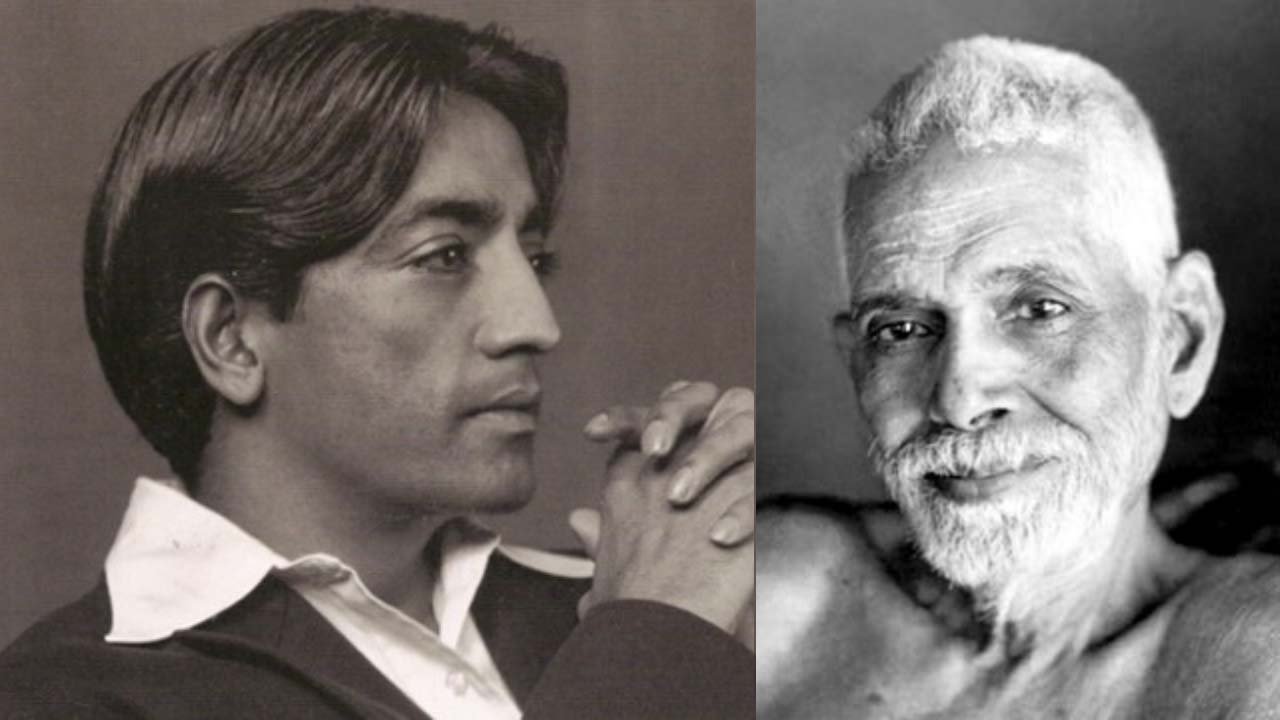
J.Krishnamurti’s, Dissolution of the Order of the Star
Krishnamurti dissolves the Order of the Star, affirming truth is pathless and self‑discovered, beyond organizations, leaders, or authority.

Meditation
Practiced diligently, meditation techniques purify the mind because they bring awareness to unholy patterns of thought and feeling. Unhealthy thoughts cannot survive the penetrating light of awareness. Nothing purifies like experience of the Self, which releases a flood of healing, cleansing, spiritual energy into the conscious and unconscious minds.
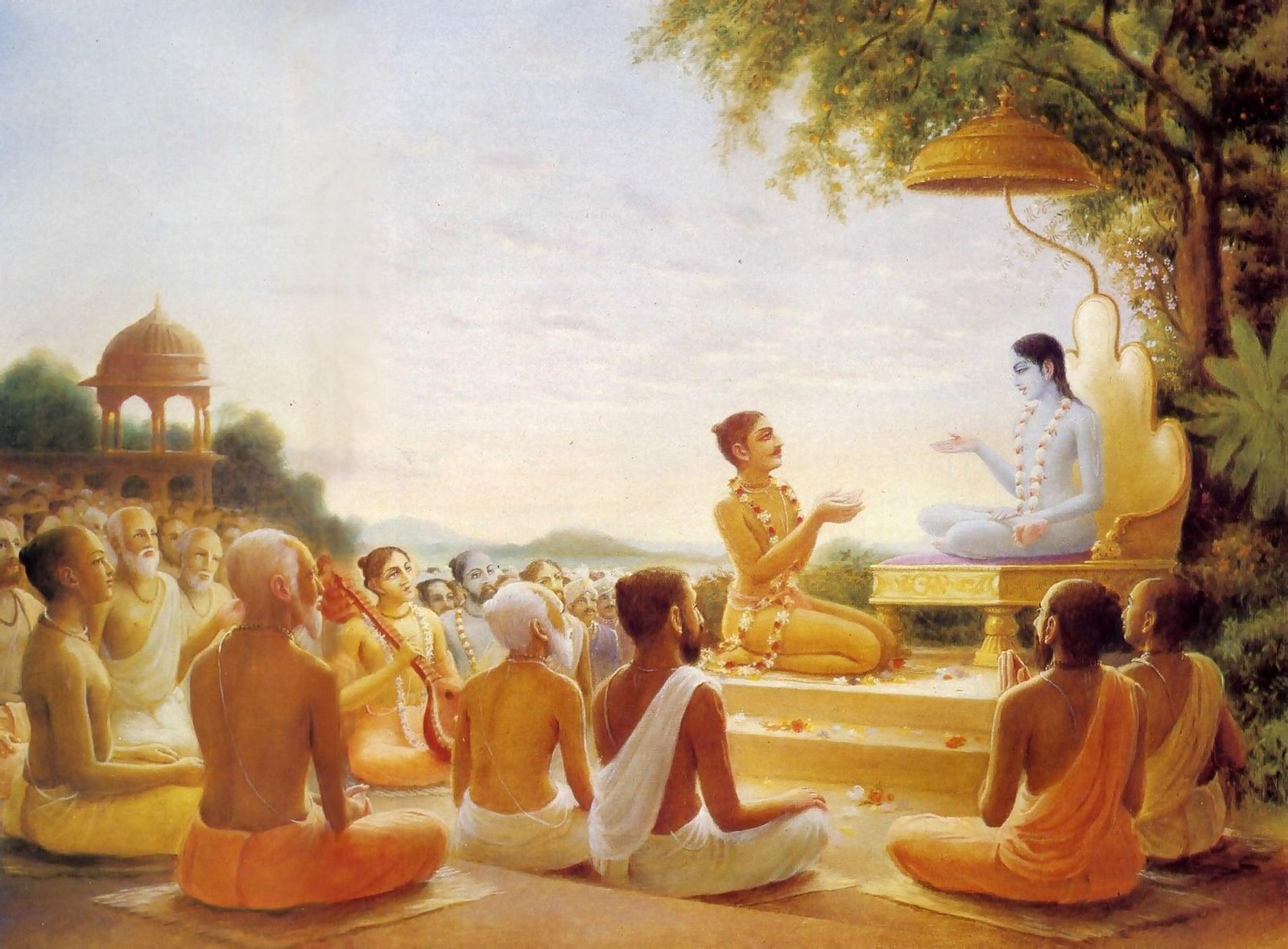
Qualifications for Satsang
There are certain qualifications to be fulfilled before one goes to a teacher for freedom.
The first requirement, discernment, is discrimination between what is real and what is unreal. This distinction is essential. You must desire what is real and reject what is unreal. What is real can only be truth. Your own Self. There is nothing beyond this. All the rest is falsehood…

Letters to Bhagavan
Letters to Bhagavan, answered by a Brahmin scribe, carried the Master’s imprimatur, preserving his teaching and direct spiritual essence.

A Dog and A Monkey
Through Grace and surrender, one is lifted beyond samsara, like the monkey safe from the barking dog, untouched.

Natures silence
SHY CRABS
AT SUNSET TIME
PERCHED ON THE EDGE
OF THEIR SAND HOLES

Obstacles which Hinder Realisation of the Self.
Realisation is hindered by habits of thought; overcome by tracing thoughts to their source and resting in pure, timeless Being.
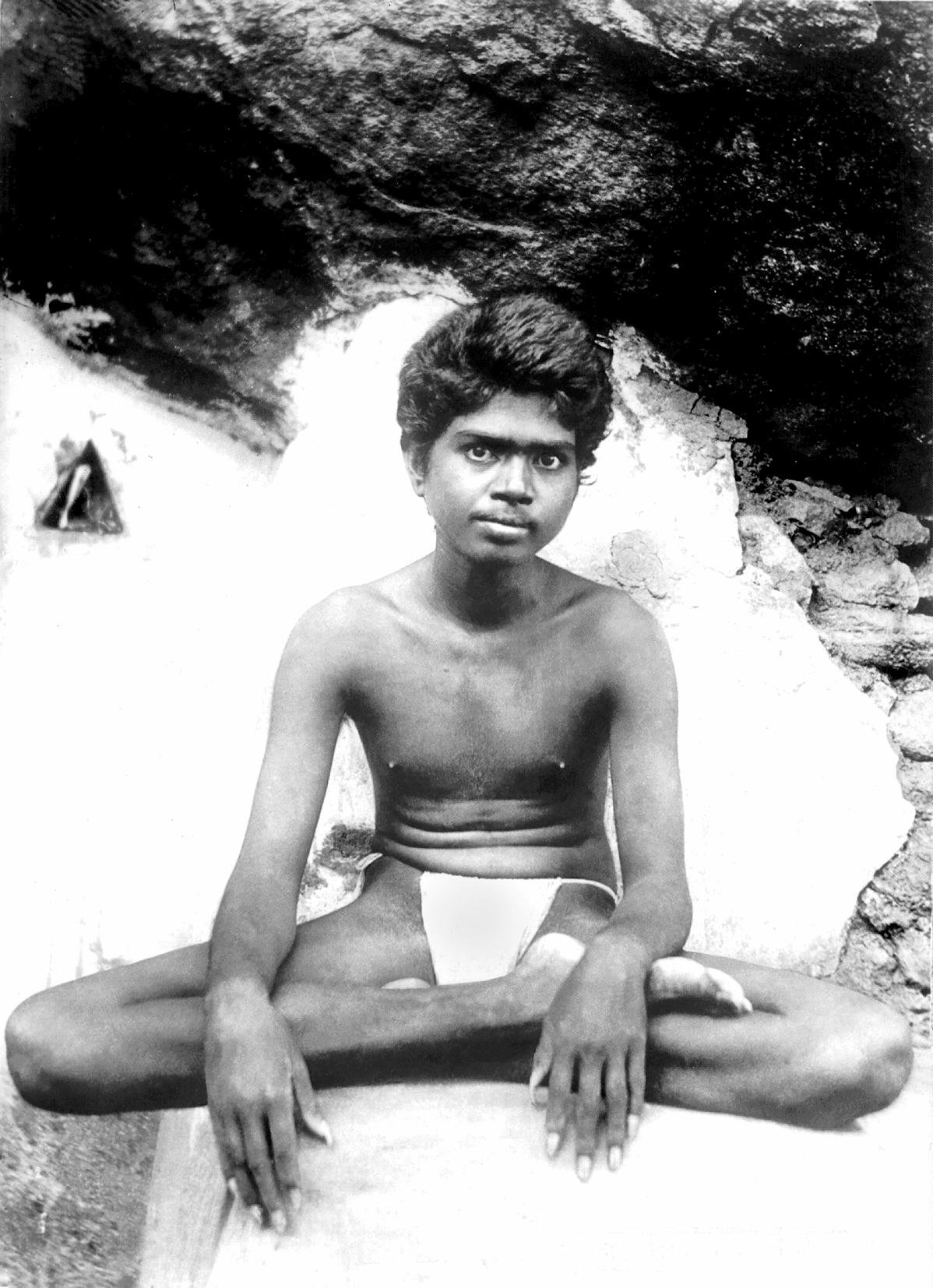
40th Anniversary Event
The 40th anniversary of Bhagavan’s union with Arunachala was celebrated with reverence, and grace, with him attending to every detail.

Authentic Intimacy
Authentic Intimacy becomes possible when two people meet without the daily drama of “my life.” This relating is about presence, just being there in a dance with the other. Being present with everything that simply is.

An Individual Connection to the Master
“Wow, this silence and bliss is so beautiful.” He gets up and says, “I’m going downstairs to make some yoghurt.” So, I follow Him down, and I said, “Why did you do that?” He said, “Where’s your silence now?” I said, “Well, it’s still here.” He said, “This is why I did it.”
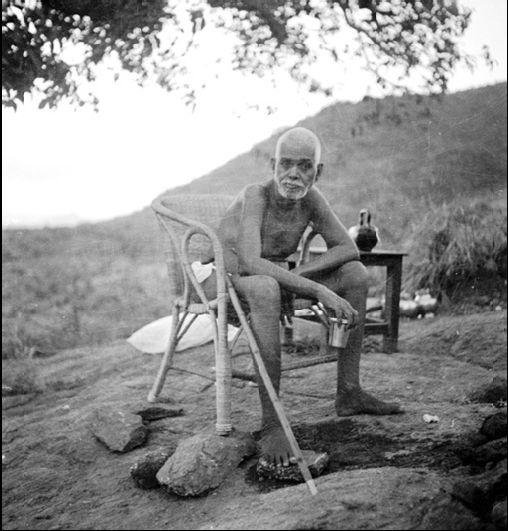
Consciousness
The “I”-sense is not even remotely connected to anything physical. Being of the nature of consciousness, it emanates from the Self only.

